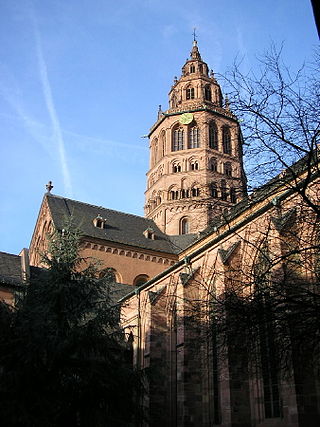
Boniface was an English Benedictine monk and leading figure in the Anglo-Saxon mission to the Germanic parts of Francia during the eighth century. He organised significant foundations of the church in Germany and was made bishop of Mainz by Pope Gregory III. He was martyred in Frisia in 754, along with 52 others, and his remains were returned to Fulda, where they rest in a sarcophagus which remains a site of Christian pilgrimage.

The Electorate of Mainz, previously known in English as Mentz and by its French name Mayence, was one of the most prestigious and influential states of the Holy Roman Empire. In the hierarchy of the Catholic Church, the Archbishop-Elector of Mainz was also the Primate of Germany, a purely honorary dignity that was unsuccessfully claimed from time to time by other archbishops. There were only two other ecclesiastical Prince-electors in the Empire: the Electorate of Cologne and the Electorate of Trier.
The Concilium Germanicum was the first major Church synod to be held in the eastern parts of the Frankish kingdoms. It was called by Carloman on 21 April 742/743 at an unknown location, and presided over by Boniface, who was solidified in his position as leader of the Austrasian church. German historian Gunther Wolf judges that the Concilium was the high point in Boniface's long career.

Fritzlar is a small town in the Schwalm-Eder district in northern Hesse, Germany, 160 km (99 mi) north of Frankfurt, with a storied history.

The Büraburg was a prominent hill castle with historic significance, on the Büraberg hill overlooking the Eder river near the town of Fritzlar in northern Hesse (Germany). Only foundation walls remain, and a church dedicated to St. Brigida.
Witta of Büraburg was one of the early Anglo-Saxon missionaries in Hesse and Thuringia in central Germany, disciple and companion of Saints Boniface and Lullus. Following the establishment by Boniface of the bishopric of Büraburg near Fritzlar in 741, Witta was the first and only bishop there. After his death on 26 October 747, no successor was appointed and Lullus, then archbishop of Mainz, incorporated the bishopric into his own because he wanted to have control over the Christian missionary efforts towards the East. Witta was buried in the chapel of Saint Sturm which Lullus later (769) used as the nucleus for the new and influential Benedictine Hersfeld Abbey.

Donar's Oak was a sacred tree of the Germanic pagans located in an unclear location around what is now the region of Hesse, Germany. According to the 8th century Vita Bonifatii auctore Willibaldo, the Anglo-Saxon missionary Saint Boniface and his retinue cut down the tree earlier in the same century. Wood from the oak was then reportedly used to build a church at the site dedicated to Saint Peter. Sacred trees and sacred groves were widely venerated by the Germanic peoples.

Wigbert, (Wihtberht) born in Wessex around 675, was an Anglo-Saxon Benedictine monk and a missionary and disciple of Boniface who travelled with the latter in Frisia and northern and central Germany to convert the local tribes to Christianity. His feast day is August 13 in the Roman Catholic Church and the Eastern Orthodox Church.
Lambert of Hersfeld was a medieval chronicler. His work represents a major source for the history of the German kingdom of Henry IV and the incipient Investiture Controversy in the eleventh century.

Benediktbeuern Abbey is an institute of the Salesians of Don Bosco, originally a monastery of the Benedictine Order, in Benediktbeuern in Bavaria, near the Kochelsee, 64 km south-south-west of Munich. It is the oldest and one of the most beautiful monasteries in Upper Bavaria. It was badly damaged in an extreme weather event in 2023.

Altomünster Abbey was a monastery in the small Bavarian market town of Altomünster.

Hersfeld Abbey was an important Benedictine imperial abbey in the town of Bad Hersfeld in Hesse, Germany, at the confluence of the rivers Geisa, Haune and Fulda. The ruins are now a medieval festival venue.
Ohrdruf Priory or Karmel St. Elija, Ohrdruf, is a Carmelite monastery at Ohrdruf in Thuringia, Germany. It is the latest in a series of religious foundations in the town:
Saint Edburga of Minster-in-Thanet was a princess of Wessex, and abbess of Minster-in-Thanet. She is regarded as a saint.
Theodor Schieffer was a German historian. He was professor of medieval history at the University of Mainz, then at the University of Cologne, and since 1952 he was president of the Association for Middle Rhine Church History. He is the author of Winfrid-Bonifatius und die christliche Grundlegung Europas, the authoritative biography of Saint Boniface.
Sturm, also called Sturmius or Sturmi, was a disciple of Boniface and founder and first abbot of the Benedictine monastery and abbey of Fulda in 742 or 744. Sturm's tenure as abbot lasted from 747 until 779.
The Codex Vindobonensis 751, also known as the Vienna Boniface Codex, is a ninth-century codex comprising four different manuscripts, the first of which is one of the earliest remaining collections of the correspondence of Saint Boniface. The codex is held in the Austrian National Library in Vienna.
Megingoz was the second bishop of Würzburg from 753 until his retirement in 768.
Michael Tangl was an Austrian scholar of history and diplomatics, and one of the main editors of the Monumenta Germaniae Historica, for whom he published the correspondence of Saint Boniface, an edition still used by scholars and considered the definitive edition.

The Free City of Mainz was a city-state that existed from 13 BC to 1803 in the early Middle Ages, which played a crucial role in the Christianization of the German and Slavic communities during the Middle Ages.











